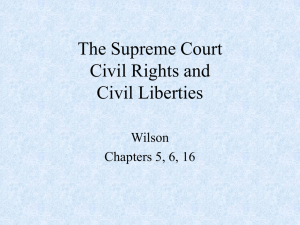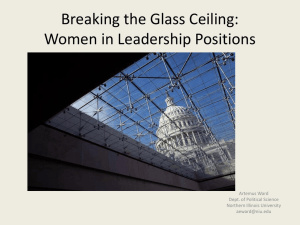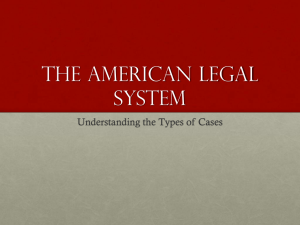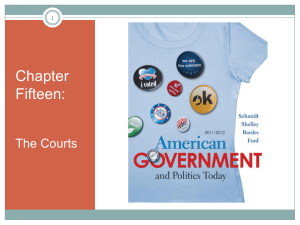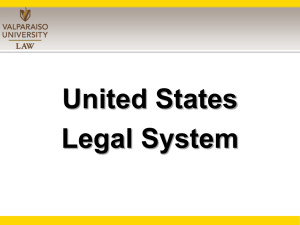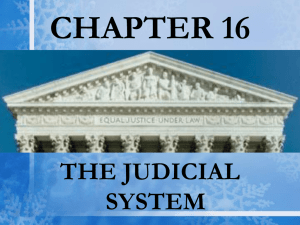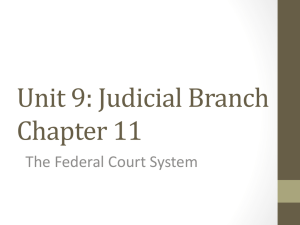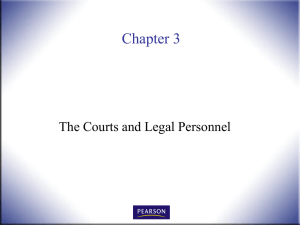Chapter 18 Power Point
advertisement
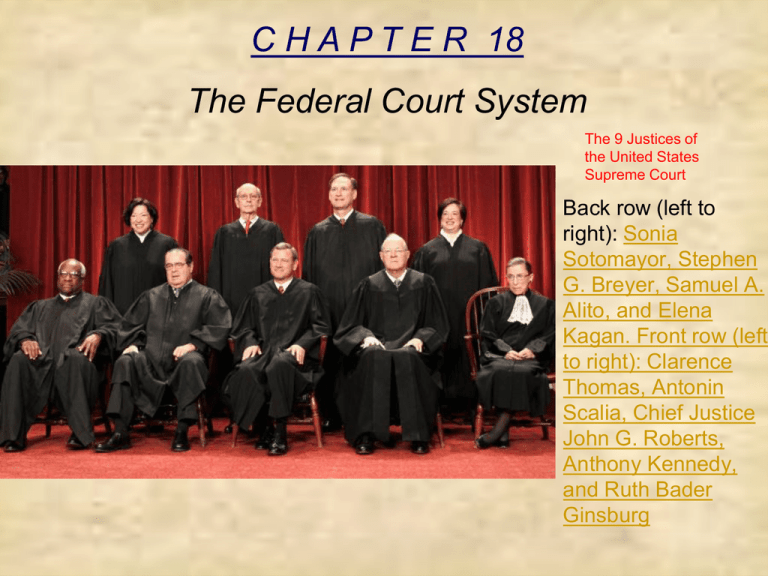
C H A P T E R 18 The Federal Court System The 9 Justices of the United States Supreme Court Back row (left to right): Sonia Sotomayor, Stephen G. Breyer, Samuel A. Alito, and Elena Kagan. Front row (left to right): Clarence Thomas, Antonin Scalia, Chief Justice John G. Roberts, Anthony Kennedy, and Ruth Bader Ginsburg C H A P T E R 18 The Federal Court System SECTION 1 The National Judiciary SECTION 2 The Inferior Courts SECTION 3 The Supreme Court SECTION 1 The National Judiciary – Key Questions •Why did the Constitution create a national judiciary? •What is the structure of the national judiciary? •What criteria are used to determine the jurisdiction of a federal court case? •How are federal judges appointed, and what are their terms? Creation of a National Judiciary The Framers created the national judiciary in Article III of the Constitution: “The Judicial Power of the United States shall be vested in one supreme Court, and in such inferior Courts as the Congress may from time to time ordain and establish.” – Article III, Section 1 • The Constitution created the Supreme Court and left Congress to establish the inferior courts—the lower federal courts. There are two types of federal courts: (1) constitutional courts and (2) special courts. Most federal cases are heard in the Constitutional courts. Creation of the National Judiciary • There are two court systems in the United States: the national judiciary that spans the country and has more than 100 courts, and the courts run by each of the 50 States and there numbers run into the thousands. • Most cases heard today are heard in the State, not the federal, courts. Types of Federal Courts •The Constitution created only the Supreme Court, giving Congress the power to create any lower, or “inferior,” courts as needed. 2 3 4 Chapter 18, Section 1 Federal Court Jurisdiction •Jurisdiction - is defined as the authority of a court to hear (to try and to decide) a case. Article III, Section 2 of the Constitution provides that the FEDERAL courts may hear a case because either: (1) the subject matter (federal laws and enumerated powers) or (2) the parties involved in the case (States, ambassadors). • All cases not heard in federal courts, are within the jurisdiction of the States’ courts. Types of Jurisdiction •exclusive jurisdiction – cases •A court in which a case is first that can only be heard in federal court (ex: counterfeiting, mail fraud, treason, federal property). •concurrent jurisdiction –can be tried in federal or State court (diversity suits – involving citizens of different States). •Federal courts may hear cases involving diverse citizenship only if the amount involved is over $75,000. •Plaintiff is person who files suit. Defendant is person whom the complaint is against. heard is said to have original jurisdiction over that case. •A court that hears a case on appeal from a lower court has appellate jurisdiction over that case. (This higher court may uphold, overrule, or modify the decision appealed from the lower court). •The Supreme Court exercises both original and appellate jurisdiction, but only has original jurisdiction in certain cases involving ambassadors or disputes amongst States. Appointment of Judges •“shall nominate, and by and with the Advice and Consent of the Senate, shall appoint… Judges of the supreme Court.” – Article II, Section II, Clause 2 •Most federal judges are drawn from the ranks of leading attorneys, legal scholars and law profs, former Congress, and State courts members. President Obama appointed Justice Sonia Sotomayor (right) – and Elana Kagan (left) as US Supreme Court Justices. 3 4 Chapter 18, Section 1 Terms and Pay of Judges •Judges on S Court are appointed for life. •Judges of S Court may only be removed by their own will or through impeachment. •Congress determines salaries for federal judges. •Today, $213,000 for Supreme Court Justices. Section 1 Review 1. Which of the following is the only court established by the Constitution? (a) the United States Court of Appeals (b) the United States Supreme Court (c) the Supreme Court of Texas (d) the United States Court of Federal Claims 2. Federal judges are appointed by (a) governors of States with federal courts. (b) the Vice President. (c) the President. (d) State legislatures. SECTION 2 The Inferior Courts •What is the structure and jurisdiction of the federal district courts? •What is the structure and jurisdiction of the federal courts of appeals? •What is the structure and jurisdiction of other constitutional courts? The Federal District Courts Federal Judicial Districts District Court Jurisdiction •The 94 federal judicial districts •District courts have original include at least one district in each State, the District of Columbia, and Puerto Rico. jurisdiction over most cases that are heard in federal courts. •Larger and more populous States are divided into two or more districts, reflecting the larger amount of judicial work done there. •The district courts hear a wide range of criminal cases and civil cases. •A criminal case, in the federal courts, is one in which a defendant is tried for committing some action that Congress declared by law to be a federal crime (counterfeiting). •A federal civil case is one which involves noncriminal matters (land dispute). The Courts of Appeals The courts of appeals were created in 1891 to handle much of the burden that the Supreme Court faced in ruling on appealed cases. Appellate Court Judges •Altogether, 179 circuit judges sit in the 12 appeals courts. •Appellate Court Jurisdiction •The courts of appeals only have appellate jurisdiction, hearing cases on appeal from lower federal courts (They can uphold, overturn, or modify lower court rulings. Decisions are final unless Supreme Court agrees to try the case). Federal District courts and appeals courts How Federal Cases Are Appealed Other Constitutional Courts The Court of International Trade •The Court of International Trade hears civil cases arising out of tariff and other trade-related laws. The Court of Appeals for the Federal Circuit •This appellate court has nationwide jurisdiction and hears cases from several different courts. It was created to speed up the handling of certain civil cases. Headquartered in D.C. (NOT to be confused with U.S. Court of Appeals for D.C.). •Most cases heard arise from the U.S. Court of International Trade, patent, trademark, and copyright cases coming from the 94 district courts, and the U.S. Court of Appeals for Veterans Claims. Section 2 Review 1. The Federal District Courts have (a) original jurisdiction over most cases that are heard in the federal courts. (b) appellate jurisdiction over federal cases. (c) original jurisdiction in matters involving two or more of the States. (d) appellate jurisdiction over all cases. 2. The courts of appeals hear which types of cases? (a) cases in which the Supreme Court has already made a decision (b) cases in which they have appellate jurisdiction (c) cases in which they have original jurisdiction (d) cases brought to them by State supreme courts SECTION 3 The Supreme Court •What is the concept of judicial review? •What is the scope of the Supreme Court’s jurisdiction? •How do cases reach the Supreme Court? •How does the Supreme Court operate? Judicial Review Judicial review - refers to the power of a court to determine the constitutionality of a government action. Constitution = “Supreme law of the land.” The Constitution does not explicitly give the power of judicial review. Still, there is little doubt that the framers intended that the Supreme Court should have this power. It has been implied from the following: • “The judicial Power of the United States, shall be vested in one Supreme Court, and in such inferior Courts as the Congress may from time to time ordain and establish.” – Article III, Section 1 • “The judicial Power shall extend to all Cases, in Law and Equity, arising under this Constitution, the Laws of the United States, and Treaties made, or which shall be made, under their Authority;” – Article III, Section 2 Marbury v Madison (1803) Established Power of Judicial Review • Jefferson won the Presidency in 1800. • Adams attempted to “pack” the judiciary with loyal party members. • The Senate confirmed William Marbury and other “midnight justices.” • The next day, Jefferson became President. Angered by the attempted “packing” he ordered his Secretary of State, James Madison, not to deliver the commissions that were signed by Adams the night before. • Marbury requested a court order from the Supreme Court, basing his case on a provision in the Judiciary Act of 1789, in which Congress gave the Supreme Court the right to hear such a case in its original jurisdiction (not on appeal). • The Court refused Marbury’s request, finding the section of Judiciary Act to be in conflict with the Constitution, and therefore his request was void. The Judiciary Act conflicted with this provision in the Constitution: • “In all Cases affecting Ambassadors, other public Ministers and Consuls, and those in which a State shall be Party, the supreme Court shall have original jurisdiction.” – Article III, Section 2, Clause 2 Supreme Court Jurisdiction •The Supreme Court has both original (involving States, ambassadors) and appellate jurisdiction (brought by appeal). •Most all cases heard by the Supreme Court are appeals cases. Chapter 18, Section 3 How Cases Reach the Supreme Court For a case to be heard by the S. Court, four of nine judges must agree that it should be placed on the Court’s docket (to be heard). How the Supreme Court Operates Oral Arguments • Once the Supreme Court accepts a case, it sets a date on which lawyers on both sides will present oral arguments. Briefs • Briefs are written documents filed with the Court before oral arguments begin. The Court in Conference • The Chief Justice presides over a closed-door conference in which justices present their views on the case at hand. Opinions of the Court Once the Court finishes its conference, it reaches a decision and its opinion is written. Section 3 Review 1. The Supreme Court has which type of jurisdiction? (a) only original jurisdiction (b) only appellate jurisdiction (c) appellate and original jurisdiction (d) none of the above 2. The majority opinion of a Supreme Court case is (a) the decision made on a case by the Court. (b) written by those justices that voted in favor of a case. (c) never used as precedent in a court of law. (d) often authored by the justice holding the least seniority.


